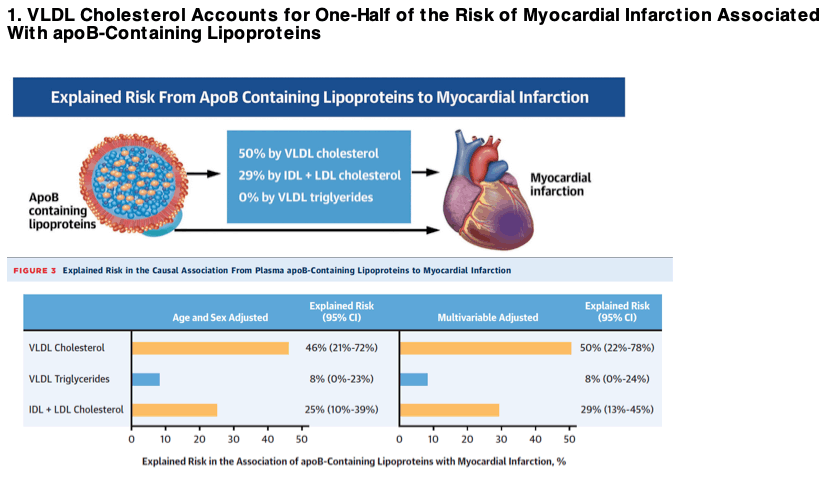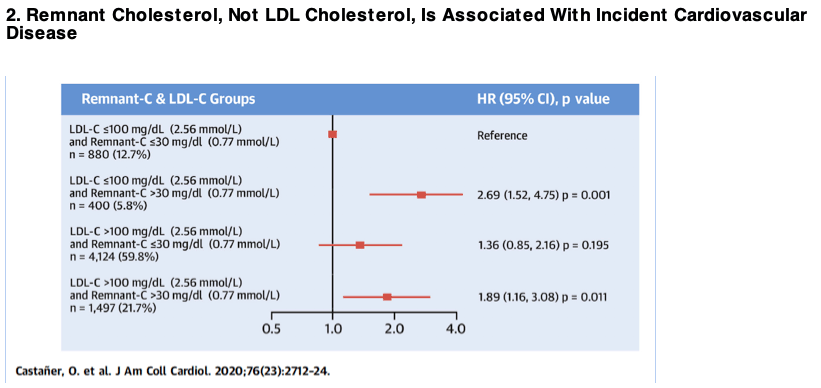| |
Are LDL as Important in CVD ? Remnant Cholesterol and Atherosclerotic Cardiovascular Disease Risk
|
| |
| |
Download the PDF here
Download the PDF here
Download the PDF here
2 studies published in Nov 2020 JACC - Jnl of the American College of Cardiology, raise questions about the causes of heart events beyond only LDL, and discuss other lipids that they suggest may play more important roles in heart events. Attached are both studies & the Editorial Comment.
In a primary prevention cohort of participants at high cardiovascular risk in the PREDIMED trial, baseline triglycerides, estimated remnant-C and non−HDL-C, but not LDL-C or HDL-C, were associated with major CVD events, regardless of intervention group, other clinical phenotypes (obesity and diabetes), lifestyle confounders related to both lipid concentrations and cardiovascular risk, and lipid-lowering treatment.
PREDIMED and CGPS, although distinct in design and analytical methods, yielded complementary results. In PREDIMED, lipid-associated risk came from TG and calculated remnant cholesterol, with a negligible role for LDL cholesterol. Meanwhile, the CPGS data showed that directly measured cholesterol within VLDL particles explains one-half of the MI risk attributable to apo B–containing lipoproteins. Notably, TG within VLDL was not associated with ASCVD events. Thus, in contrast to PREDIMED, CGPS gives LDL some credit, even if it seems dwarfed by the effect of VLDL cholesterol.
What do these studies mean for the clinical cardiologist? For example, should we now shelve LDL cholesterol and embrace VLDL and remnant cholesterol as the new oracles of ASCVD risk (17)? Not so fast. It would be premature to discard LDL cholesterol based on PREDIMED, which was a 4.8-year study with only 263 total MACE events. This is insufficient to offset the mountain of literally hundreds of studies and independent types of experiments that uphold the value of LDL cholesterol in prediction and intervention of ASCVD (4,5). In contrast, CGPS indicates that although VLDL cholesterol is the new kid in town for prediction, LDL cholesterol retains predictive power. Replication of the CGPS results would be desirable. The NMR methodology, although promising, is relatively new, expensive, and not widely available, and it needs to be further field tested and validated. However, if these results can be replicated, they represent a potential advance for diagnosis and prevention of ASCVD endpoints. One could envision a future where in addition to the routine lipid profile, newer analytes such as remnant cholesterol as well as lipoprotein(a) and apo B are reported to improve prognostication and help guide preventive treatments (18).
A striking recent development in lipidology has been the renaissance of plasma triglycerides (TG) as a risk factor and likely causal agent for atherosclerotic cardiovascular disease (ASCVD).
Several therapeutic strategies are available to lower triglycerides and remnant-C levels (44). High-intensity statin treatment lowers triglycerides modestly (28), whereas fibrates have a more profound triglyceride-lowering effect while effectively reducing CVD risk in subjects with atherogenic dyslipidemia (45–47). PCSK9 inhibitors can be used when statin and/or ezetimibe doses have been optimized or there is intolerance to statins, but triglyceride lowering is also modest with these agents (48,49). In contrast, high-dose n-3 fatty acids, particularly icosapent ethyl (ethyl eicosapentaenoic acid) (48), and newer agents, such RNA-based antisense- oligonucleotide inhibitors of apolipoprotein C-III and angiopoietin-like 3 genes (49,50), markedly reduce TRLs. Nevertheless, it remains to be tested in randomized clinical trials whether this approach would be superior, in terms of CVD prevention, to a more intensive LDL-C lowering strategy, particularly in subjects at high CVD risk with elevated triglycerides, even when risk-specific LDL-C targets have been reached.
So, PREDIMED and CGPS, although distinct in design and analytical methods, yielded complementary results. In PREDIMED, lipid-associated risk came from TG and calculated remnant cholesterol, with a negligible role for LDL cholesterol. Meanwhile, the CPGS data showed that directly measured cholesterol within VLDL particles explains one-half of the MI risk attributable to apo B–containing lipoproteins. Notably, TG within VLDL was not associated with ASCVD events. Thus, in contrast to PREDIMED, CGPS gives LDL some credit, even if it seems dwarfed by the effect of VLDL cholesterol.
What do these studies mean for the clinical cardiologist? For example, should we now shelve LDL cholesterol and embrace VLDL and remnant cholesterol as the new oracles of ASCVD risk (17)? Not so fast. It would be premature to discard LDL cholesterol based on PREDIMED, which was a 4.8-year study with only 263 total MACE events. This is insufficient to offset the mountain of literally hundreds of studies and independent types of experiments that uphold the value of LDL cholesterol in prediction and intervention of ASCVD (4,5). In contrast, CGPS indicates that although VLDL cholesterol is the new kid in town for prediction, LDL cholesterol retains predictive power. Replication of the CGPS results would be desirable. The NMR methodology, although promising, is relatively new, expensive, and not widely available, and it needs to be further field tested and validated. However, if these results can be replicated, they represent a potential advance for diagnosis and prevention of ASCVD endpoints. One could envision a future where in addition to the routine lipid profile, newer analytes such as remnant cholesterol as well as lipoprotein(a) and apo B are reported to improve prognostication and help guide preventive treatments (18).

Results
During a median 11 years of follow-up, 1,816 were diagnosed with myocardial infarction. Per 1-mmol/l higher levels, multivariable-adjusted hazard ratios for myocardial infarction were 2.07 (95% confidence interval [CI]: 1.81 to 2.36) for VLDL cholesterol, 1.19 (95% CI: 1.14 to 1.25) for VLDL triglycerides, 5.38 (95% CI: 3.73 to 7.75) for IDL cholesterol, and 1.86 (95% CI: 1.62 to 2.14) for LDL cholesterol. Per 1-g/l higher plasma apoB, the corresponding value was 2.21 (95% CI: 1.90 to 2.58). In a step-up Cox regression, risk factors for myocardial infarction entered by importance as VLDL cholesterol, systolic blood pressure, smoking, and IDL + LDL cholesterol, whereas VLDL triglycerides did not enter the model. VLDL cholesterol explained 50% and IDL + LDL cholesterol 29% of the risk of myocardial infarction from apoB-containing lipoproteins, whereas VLDL triglycerides did not explain risk.
Conclusions
VLDL cholesterol explained one-half of the myocardial infarction risk from elevated apoB-containing lipoproteins, whereas VLDL triglycerides did not explain risk.
-------------------------------

Conclusions
Our results showed that levels of triglycerides and estimated remnant-C, but not LDL-C or HDL-C, were associated with CVD outcomes independently of lifestyle characteristics and other cardiovascular risk factors in a cohort of Mediterranean subjects at high risk with a high prevalence of diabetes and obesity. Remnant-C should be considered a preferential treatment target in this population. Randomized controlled trials with hard CVD outcomes are warranted to compare the benefit of interventions directed at lowering remnant-C against standard cholesterol-lowering therapy, particularly when LDL-C target levels have been achieved.
Abstract
Background
Genetic, observational, and clinical intervention studies indicate that circulating levels of triglycerides and cholesterol transported in triglyceride-rich lipoproteins (remnant cholesterol) can predict cardiovascular events.
Objectives
This study evaluated the association of triglycerides and remnant cholesterol (remnant-C) with major cardiovascular events in a cohort of older individuals at high cardiovascular risk.
Methods
This study determined the baseline lipid profile and searched for major adverse cardiovascular events (MACEs) in the high-risk primary prevention PREDIMED (Prevención con Dieta Mediterránea) trial population (mean age: 67 years; body mass index: 30 kg/m2; 43% men; 48% with diabetes) after a median follow-up of 4.8 years. Unadjusted and adjusted Cox proportional hazard models were used to assess the association between lipid concentrations (either as continuous or categorical variables) and incident MACEs (N = 6,901; n cases = 263).
Results
In multivariable-adjusted analyses, triglycerides (hazard ratio [HR]: 1.04; 95% confidence interval [CI]: 1.02 to 1.06, per 10 mg/dl [0.11 mmol/l]; p < 0.001), non−high-density lipoprotein cholesterol (HDL-C) (HR: 1.05; 95% CI: 1.01 to 1.10, per 10 mg/dl [0.26 mmol/l]; p = 0.026), and remnant-C (HR: 1.21; 95% CI: 1.10 to 1.33, per 10 mg/dl [0.26 mmol/l]; p < 0.001), but not low-density lipoprotein cholesterol (LDL-C) or HDL-C, were associated with MACEs. Atherogenic dyslipidemia (triglycerides >150 mg/dl [1.69 mmol/l] and HDL-C <40 mg/dl [1.03 mmol/l] in men or <50 mg/dl [1.29 mmol/l] in women) was also associated with MACEs (HR: 1.44; 95% CI: 1.04 to 2.00; p = 0.030). Remnant-C ≥30 mg/dl (0.78 mmol/l) differentiated subjects at a higher risk of MACEs compared with those at lower concentrations, regardless of whether LDL-C levels were on target at ≤100 mg/dl (2.59 mmol/l).
Conclusions
In overweight or obese subjects at high cardiovascular risk, levels of triglycerides and remnant-C, but not LDL-C, were associated with cardiovascular outcomes independent of other risk factors.
|
|
| |
| |
|
|
|